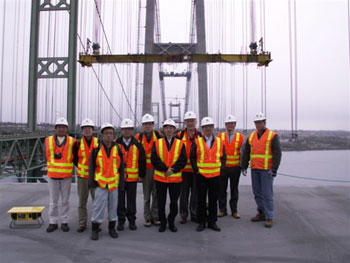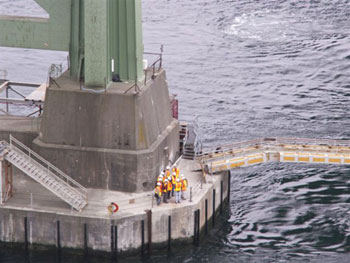U.S. Department of Transportation
Federal Highway Administration
1200 New Jersey Avenue, SE
Washington, DC 20590
202-366-4000
Focus
| Accelerating Infrastructure Innovations |
Publication Number: FHWA-HRT-07-010
Date: January/February 2007
Advancing bridge engineering technology in the United States and Japan brought 60 representatives from both countries to the 22nd U.S.-Japan Bridge Engineering Workshop in Seattle, Washington, in October 2006. "The workshop's major themes this year were geotechnical engineering, structural health monitoring, and advanced seismic technologies, serving as an important technology exchange vehicle between the two countries," says Phillip Yen of the Federal Highway Administration (FHWA) and U.S. chairman for the workshop. The annual event is sponsored by the Transportation Task Committee of the U.S.-Japan Cooperative Research Program in Natural Resources' Panel on Wind and Seismic Effects.
U.S. participants included representatives from FHWA, State departments of transportation, industry, and academia. The Japanese delegation included representatives from the Public Works Research Institute of the Japan Ministry of Construction, academia, and industry. "It was an excellent opportunity to learn about the research and work being done in the two countries," says Jugesh Kapur, State Bridge Engineer for the Washington State Department of Transportation (WSDOT).
Bridge structural health monitoring, seismic performance of bridge foundations and footings, application of inspection data for highway bridge management, and geotechnical seismic design policy were among the featured topics at the workshop. Also highlighted was FHWA's new Long-Term Bridge Performance (LTBP) program. This 20-year research effort will include detailed inspection, periodic evaluation and testing, continuous monitoring, and forensic investigation of representative samples of bridges nationwide. The data collected will be used to develop a quantitative database for highway bridges that will provide increased knowledge about bridge performance and degradation and support better design methods, improved performance predictive models, and advanced bridge management tools. For more information on the LTBP program, visit www.tfhrc.gov/structur/ltbp.htm.
Following the workshop, members of the Japanese delegation participated in a 3-day guided technical tour of new bridge construction, moveable bridges, and seismically-retrofitted bridges in the Seattle area, including the new Tacoma Narrows suspension bridge and two floating bridges. The technical tour was hosted by the City of Seattle and the WSDOT. "There was particular interest in visiting the floating bridges, which are unique. We took participants inside the bridge pontoons. Participants also expressed great interest in the Tacoma Narrows bridge construction," says Kapur.
The Tacoma Narrows bridge will open in summer 2007, located parallel to the existing 1950 bridge. It is the longest suspension bridge to be built in the United States since the Verrazano Narrows Bridge opened in New York City in 1964. When retrofits to the 1950 bridge are completed in 2008, the new bridge will carry eastbound traffic and the existing bridge will carry the westbound lanes, improving safety and reducing traffic congestion. To learn more about the Tacoma Narrows Bridge project, visit www.tacomanarrowsbridge.com.
For more information on the workshop, contact Phillip Yen at FHWA, 202-493-3056 (email: wen-huei.yen@fhwa.dot.gov), or Jugesh Kapur at WSDOT, 360-705-7207 (email: kapurju@wsdot.wa.gov).
 |
| Workshop participants at the mid-span of the new Tacoma Narrows Bridge, which is under construction in Seattle, WA. |
 |
| Japanese delegates to the 22nd U.S.-Japan Bridge Engineering Workshop tour the pier foundations of the 1950 Tacoma Narrows bridge. From this location, the delegation could view the foundation and substructure of the new Tacoma Narrows bridge. |